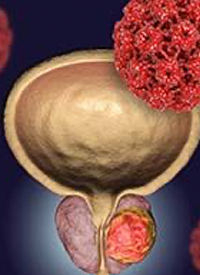Article
Enzalutamide Plus Salvage Radiation Therapy Delays PSA Progression in PSA-Recurrent High-Risk Prostate Cancer
Author(s):
Six months of enzalutamide monotherapy in combination with salvage radiation therapy postponed prostate-specific antigen progression compared with SRT alone in men with PSA-recurrent, high-risk prostate cancer.

Six months of enzalutamide (Xtandi) monotherapy in combination with salvage radiation therapy (SRT) postponed prostate-specific antigen (PSA) progression compared with SRT alone in men with PSA-recurrent, high-risk prostate cancer. Data from the phase 2 SALV-ENZA trial (NCT02203695) showed that enzalutamide induced a 58% relative improvement in increased freedom from PSA progression (FFPP).
At the time of study closure and at a median follow-up of 34 months (range, 0-52), 10 patients on the enzalutamide arm (n = 43) experienced PSA progression 9 to 39 months after random assignment. In the placebo arm (n = 43), 18 patients experienced PSA progression 4 to 33 months after random assignment. The addition of enzalutamide to SRT resulted in a significant improvement in FFPP (HR, 0.42; 95% CI, 0.19-0.92; P = .031).
Investigators recruited adult men at 7 institutes in the United States. Eligible patients had histologically confirmed adenocarcinoma of the prostate, primary treatment with radical prostatectomy, and freedom from prior malignancies for at least 3 years (with the exception of nonmelanoma skin cancers and superficial urothelial cancers). Pathological Gleason score had to be 8 to 10 or Gleason 7 with either pT3 (extracapsular extension or seminal vesicle invasion) or R1 disease (positive margins). Patients were also required to have node-negative disease (pN0) at the time of surgery and no radiographic or clinical evidence of local/regional tumor recurrence.
Patients had to have nonmetastatic disease (M0) on a CT of the abdomen and pelvis and whole-body radionuclide 99Tc bone scan or sodium fluoride PET scan within 3 months of study entry. Patients could not have received prior hormonal therapy (luteinizing hormone-releasing hormone agonist, antiandrogen, or both), and serum testosterone was greater than 150 ng/dL.
Patients were also required to have evidence of PSA relapse after prostatectomy, defined as one rise in PSA above the baseline value greater than or equal to 0.05 ng/mL. Other eligibility factors included ECOG performance status of 0 to 1, and life expectancy of at least 3 years.
Patients were randomly assigned to 180 days of placebo (n = 43) or once-daily oral enzalutamide at 160 mg (n = 43). All patients received 66.6 to 70.2 Gy in 1.8 Gy fractions for 37 to 39 doses of SRT from day 61 to day 120. Investigators stratified random assignment by center, surgical margin status (R0 v R1), PSA before salvage treatment (PSA ≥0.5 vs <0.5 ng/mL), and pathologic Gleason score (7 v 8-10).
The primary outcome measure was FFPP, defined as the time from random assignment to the date of PSA progression or if there was no progression at the time of analysis, the last PSA measurement.
Ninety percent of patients were White; 9% were Black. The median baseline pre-SRT PSA level was 0.3 ng/mL (range, 0.06-4.6). Fifty-six patients (65%) had extraprostatic disease (pT3), 39 (45%) had Gleason score of 8 to 10, and 43 (50%) had positive surgical margins (R1).
Two-year FFPP rate was 84% in the enzalutamide arm vs 66% in the control arm (P = .027). Furthermore, subgroup analyses suggested that enzalutamide provided an FFPP benefit compared with SRT alone for men with pT3 disease (HR, 0.22; 95% CI, 0.07-0.69) vs pT2 disease (HR, 1.54; 95% CI, 0.43-5.47; P interaction = .019), and those with R1 disease (HR, 0.14; 95% CI, 0.03-0.64) vs R0 disease (HR, 1.00; 95% CI, 0.36-2.76; P interaction = .023).
Investigators documented no local recurrences and only 1 metastasis event at the time of analysis, which did not represent enough events for reporting. In the enzalutamide arm, 1 patient died due to pancreatic cancer, and another patient died of unknown causes. In the placebo arm, 2 patients developed other cancers (1 had glioblastoma multiforme and 1 had squamous cell carcinoma of the tonsil), but there were no deaths.
There were 3 grade 3 adverse effects (AEs) in the enzalutamide arm (nocturia, lymphopenia, and back pain), but no AEs higher than grade 3 were reported. Seven patients in the placebo arm experienced grade 3 AEs, consisting of erectile dysfunction, fall, humerus fracture, hypertension (n = 2), nocturia, and back pain.
Reference
Tran PT, Lowe K, Tsai HL, et al. Phase II randomized study of salvage radiation therapy plus enzalutamide or placebo for high-risk prostate-specific antigen recurrent prostate cancer after radical prostatectomy: the SALV-ENZA trial. J Clin Oncol. Published online November 11, 2022. doi:10.1200/JCO.22.01662









